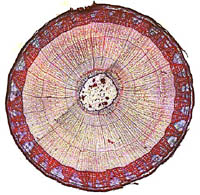"What is the purpose of the giant sequoia tree? The purpose of the giant
sequoia tree is to provide shade for the tiny titmouse." --Edward Abbey
I. Plants -- Recommended supplementary Web site:
Introduction
to the Plantae
- General notes on plant structure
- Multicellular, with several differentiated cell types (unlike algae, which
are protists).
- Almost all plants are photosynthetic and contain chlorophyll. (Exceptions:
a few saprophytic or parasitic plants, such as dodder and Indian pipe)
- Cell walls made of cellulose. When this is mature, it prevents a
plant cell from expanding in size.
- Growth occurs at the tips of roots and shoots, in special zones of
immature cells without thick cell walls. These are called meristems.
- True plants also have a waxy layer, or cuticle, surrounding the outer
layer of cells.
- Most land plants have several specialized organs:
- Roots -- absorb water and certain nutrients; may be used to store
nutrients (as in beets)
- Stems -- usually support; may photosynthesize. Underground horizontal stems are
often mistaken for roots; they're called rhizomes (crabgrass, irises, potatoes)
- Leaves -- usually the main site of photosynthesis. Modified leaves include
vine tendrils, cactus spines.
- Two broad groupings of plants:
- Bryophytes include
mosses,
plus some less-familiar plants such as liverworts and
hornworts.
These lack the water-conducting cells that form vascular tissue.
- Tracheophytes, or vascular plants, include both plants
that reproduce using seeds, and plants that do not produce seeds. (More will follow
on plant reproduction.)
- Non-seed plants include the
ferns
and
horsetails.
- Seed plants include the
sago palms,
ginkgos, conifers, and
flowering plants.
- All of these plants do have vascular tissue, which comes in two general types:
- Xylem -- transports water and minerals from roots to rest of plant.
In its mature form, xylem is made up of dead cells. (In a tree, xylem makes up the wood.)
- Phloem -- transports sugars (as sap) made by photosynthesis from leaves to
rest of plant. Mature phloem is still alive. (In a tree, phloem makes up most of the inner
bark.)
- Because bryophytes can't transport water, they usually live in very moist
habitats, and they never grow very tall. There are mosses that live in deserts,
however -- they are able to dry out completely, and then revive when water is available.
- Woody trees have xylem on the inside, phloem on the outside. . .
- . . . and in between the two, a thin ring of actively dividing tissue called the
cambium.
- The cambium lays down new xylem (on its inside) and new phloem (on its outside).
- Since the cambium is active in spring and summer, and shuts down in winter,
its action produces growth rings of xylem, virtually always one ring per year.
- Thus you can count the growth rings of a tree and determine its age.

Cross section of a young woody stem. Click on it to view an enlargement.
